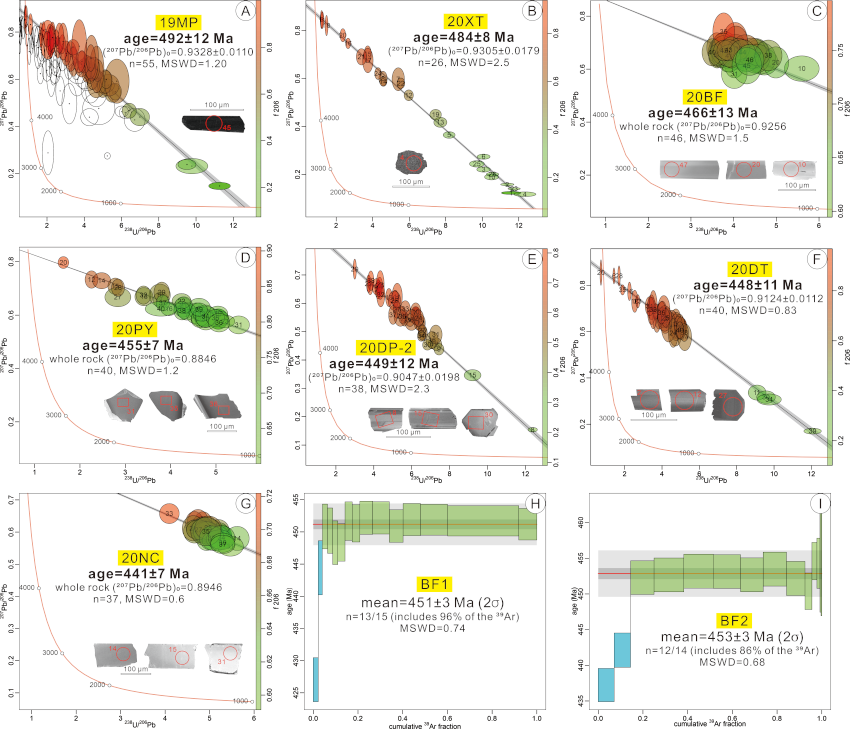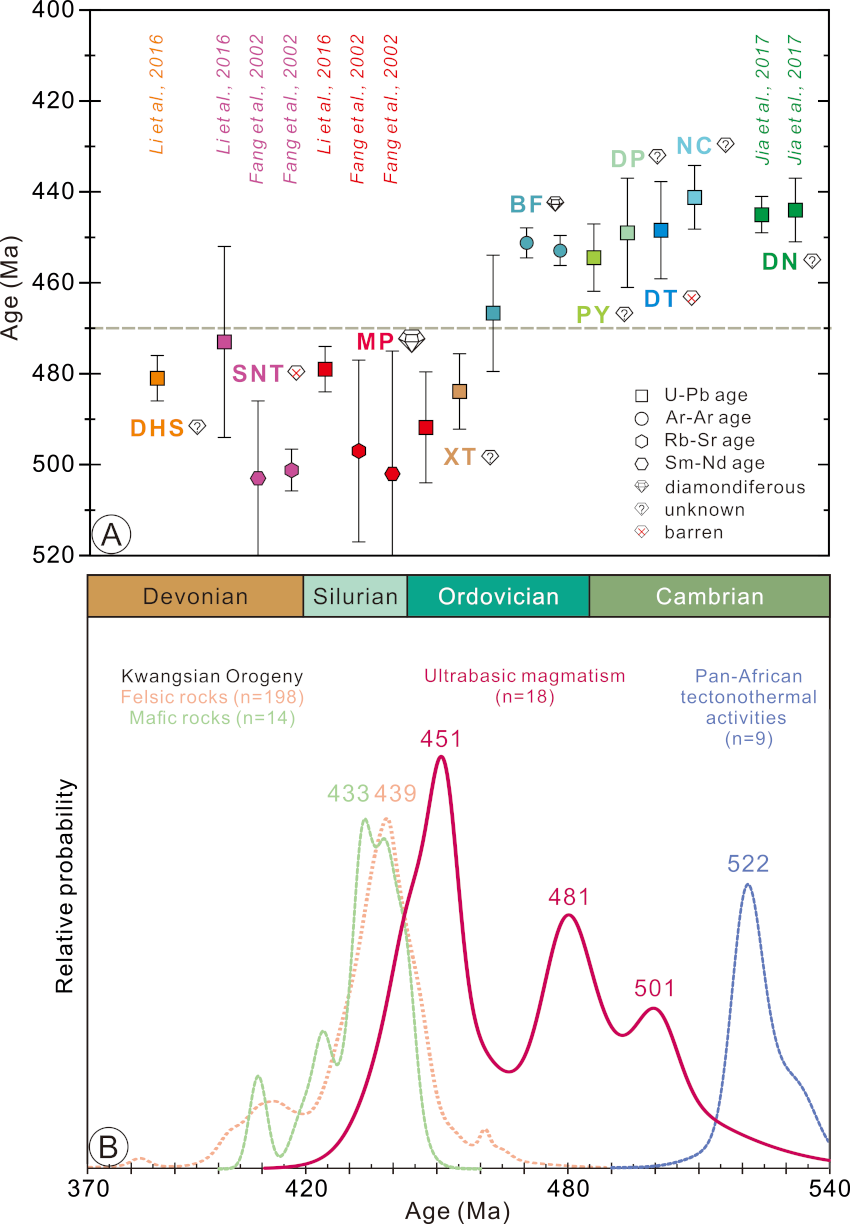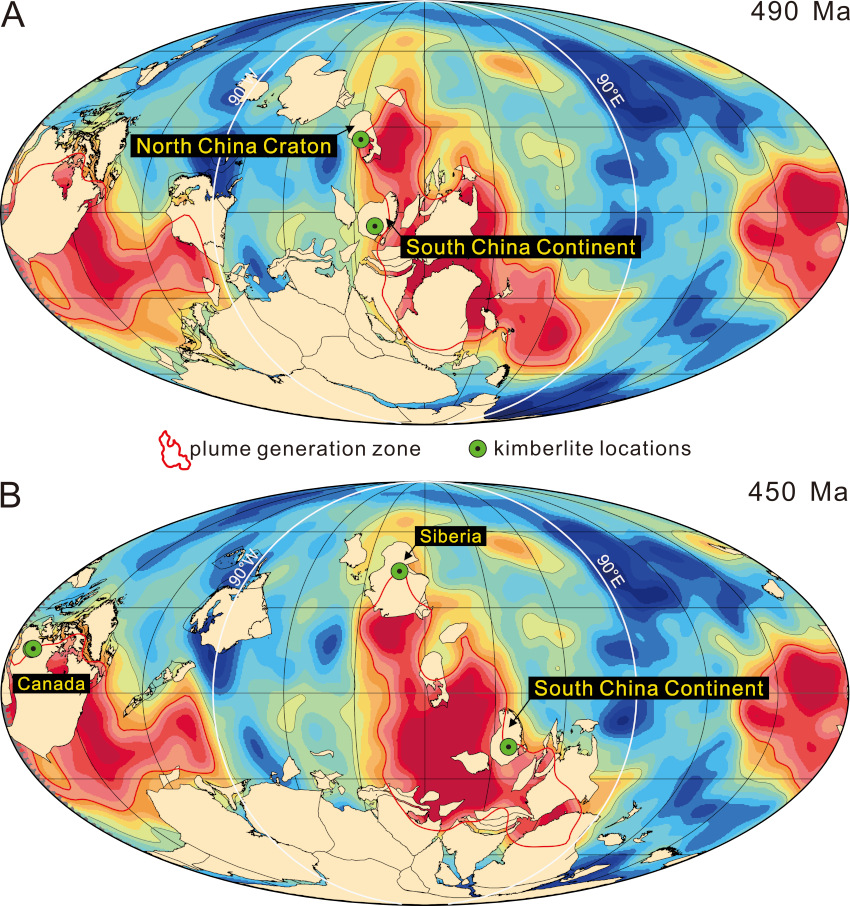January 2023 LIP of the Month
Revisiting the emplacement ages of the Early-Paleozoic diamondiferous kimberlite and related rocks in South China: upwelling from Large Low Shear Velocity Province?
Jiawei Zhang1,2,3,*, M. Santosh4,5, Yuhua Zhu1, Hongjuan Rao6, Kun Wang3, Taiping Ye7, Yonggang Li6, Weipeng Liu3
1Guizhou Geological Survey, Bureau of Geology and Mineral Exploration and Development of Guizhou Province, Guiyang 550081, China; jiaweizhang@live.cn
2Technology Innovation Center of Mineral Resources Exploration Engineering in Bedrock Zone, Ministry of Natural Resources, Guiyang 550081, China
3College of Resources and Environmental Engineering, Guizhou University, Guiyang 550025, China
4School of Earth Sciences and Resources, China University of Geosciences, Beijing 100083, China
5Department of Earth Science, University of Adelaide, Adelaide SA 5005, Australia
6101 Geological Team, Bureau of Geology and Mineral Exploration and Development of Guizhou Province, Kaili 556000, China
7Guizhou Central Laboratory of Geology and Mineral Resources, Bureau of Geology and Mineral Exploration and Development of Guizhou Province, Guiyang 550005, China
*Corresponding author. E-mail address: jiaweizhang@live.cn
Extracted and modified from:
Zhang, J., Santosh, M., Zhu, Y., Rao, H., Wang, K., Ye, T., Li, Y., Liu, W. 2023. Constraining the timing of deep magmatic pulses from diamondiferous kimberlite and related rocks in the South China Continent and implications for diamond exploration. Ore Geology Reviews, 105328. https://doi.org/10.1016/j.oregeorev.2023.105328
Introduction
Kimberlitic magmas are the deepest-rooted mantle-derived melts among all terrestrial magmas (Sautter et al., 1991; Haggerty, 1999; Pearson et al., 2014; Nestola et al., 2018), they can transport mantle xenoliths and diamonds along its ascent, thus providing valuable insight into the composition of the deep mantle (Woodhead et al., 2019), the architecture of craton (Gardiner et al., 2020), diamond formation (Heaman et al., 2003; Kjarsgaard et al., 2019) and the geodynamic setting during supercontinent cycle (Heaman et al., 2003; Torsvik et al., 2010, 2014; Tappe et al., 2018; Dongre et al., 2020). Decoding this important information requires precise determinations of the emplacement ages of these volatile-rich ultrabasic rocks.
Diamondiferous kimberlites are rare since only ~10% (~500) of the kimberlite pipes worldwide are diamond-bearing (Tappert and Tappert, 2011). In South China, diamondiferous kimberlite and related rocks have been recognized since 1967 (101 Geological Team of Guizhou Bureau of Geology and Mineral Resources, 1973, 1980). However, the emplacement ages and patterns of this kimberlites-lamproites-lamprophyres suite remain poorly constrained. The uncertainty of the emplacement ages of these rocks further hinders the understanding of the tectonic processes that triggered the magma genesis.
In this work, we aim to address these knowledge gaps by adopting novel (groundmass apatite U-Pb dating) and conventional (phenocryst phlogopite 40Ar-39Ar dating) geochronological dating methods on the largest diamondiferous kimberlite and lamproite dike swarm in the South China Continent. The quality of the age determination of apatite has been tested by intercalibrating the apatite U-Pb dating result with the phlogopite 40Ar-39Ar dating result on the same dike (Fig. 1). We highlight the temporal and spatial relationship between these dikes and compare them with the available geochronological data of the tectonothermal events in the South China Continent to understand their regional geodynamic significance. We then correlate the ultrabasic magmatism with the contemporaneous diamondiferous kimberlitic events worldwide and propose a new model for their genesis.

Fig. 1. Apatite cathodoluminescent images and LA-ICP-MS U-Pb dating results for ultrabasic rocks from the southeastern Guizhou Province, plotted in TeraWasserburg Concordia diagrams. (A) Maping kimberlite; (B) Xitou dike; (C) Baifen lamproite; (D) Pingyang dike; (E) Daping dike; (F) Datang dike; (G) Nanceng lamprophyre. Phlogopite 40Ar/39Ar step-heating spectra and calculated plateau ages for Baifen lamproite. BF1 (H); BF2 (I). The lower intercept U-Pb ages and the 40Ar/39Ar plateau ages were constructed by the IsoplotR (Vermeesch, 2018). The initial 207Pb/206Pb ratio of samples 20BF, 20PY, and 20NC were anchored by their whole rock 207Pb/206Pb ratios.
Discussions
As evidenced in Fig. 2a, two pulses of ultrabasic magmatism occurred in the South China Continent during the Early Paleozoic. The former one occurred during the Cambrian–Ordovician transition (488±5 Ma, N = 9, MSWD = 1.9) while the latter one marked the emplacement during the Late Ordovician period (450±3 Ma, N = 9, MSWD = 0.89). These deep-seated ultrabasic magmatic pulses seemingly lack spatiotemporal linkage (Fig. 2b) with the regional tectonothermal events in South China including the Pan-African tectonothermal event (peak at 522 Ma, Li et al., 2017, 2022; Yang et al., 2022) and the Kwangsian Orogeny (dominate at 450–430 Ma, Huang and Wang, 2019; Shu et al., 2020). Interestingly, contemporaneous deep-sourced kimberlitic events observed in the South China Continent can also be found in North China (485 to 459 Ma), Siberia (450 Ma), and Canada (459 to 435 Ma), respectively (Heaman et al., 2019 and its supplemental content).
Although these cratons and diamondiferous rocks are palaeogeographically isolated from each other, a common feature is that these cratons all lie on the surface projections of the present-day Large Low Shear Velocity Province (LLSVP) boundaries back to the time of diamondiferous kimberlitic eruptions (Torsvik et al., 2014). Specifically, the South China Continent was located above the western margin of the African LLSVP during 490 Ma and subsequently drifted to the eastern margin of the same LLSVP at 450 Ma (Fig. 3). Based on this evidence, it is suggested that the two pulses of the diamondiferous magmatism in the South China Continent might be related to minor and intermittently mantle upwellings from the edges of the African LLSVP. The thick lithosphere (>175 km) beneath the center of the South China Continent at that time is fine for kimberlitic magma eruption but maybe too thick for flood basalt generation (Ernst, pers. comm., 2023).
Our hypothesis can not only reconcile the deep-seated origin of kimberlite and their lack of spatiotemporal relationship with the shallow plate tectonics and volcanic activities, but also provide a scenario that upwelling (plumes) from the LLSVP could have led to the formation of kimberlites but not a Large Igneous Province when thick lithosphere exists.

Fig. 2. (A) Bar chart of emplacement ages of ultrabasic magmatism in the South China Continent by different dating methods, emphasizing two pulses of magmatism and their diamond occurrences. Data sources are from this study and Fang et al. (2002); Li et al. (2016); Jia et al. (2017). (B) Probability density plots on ages of Early Paleozoic tectonothermal events in the South China Continent, emphasizing two pulses of ultrabasic magmatism that pre-date the Kwangsian Orogeny but post-date the PanAfrican tectonothermal activities. Data sources: felsic rocks from Kwangsian Orogeny (Huang and Wang, 2019), mafic rocks from Kwangsian Orogeny (Jia et al., 2017; Shu et al., 2020 and references therein), Pan-African tectonothermal activities (Li et al., 2017, 2022; Yang et al., 2022).

Fig. 3. (A) Late Cambrian (490 Ma) true polar wander-corrected mantle frame reconstruction (modified after Torsvik et al., 2014); (B) Late Ordovician (450 Ma) true polar wander-corrected mantle frame reconstruction (modified after Torsvik et al., 2014).
Conclusions and perspectives
- The diamondiferous kimberlite and related rocks were emplaced at ca. 488 Ma and ca. 450 Ma in South China. Our study demonstrates that the apatite can act as a novel and robust geochronometer for constraining the emplacement age of the volatile-rich ultrabasic magma like kimberlite and lamproite.
- The occurrences of these ultrabasic dikes are temporally and spatially uncorrelated with the Pan-African tectonothermal event (peak at ca. 522 Ma) and the Kwangsian Orogeny (peak at ca. 435 Ma) recognized in the South China Continent. We envisage that kimberlite and related rocks were sourced from the edges of the fixed African Large Low Shear Velocity Province in the lowermost mantle at that time.
*Detailed geochemical studies will be required to refine the hypothesis.*
Acknowledgment:
Professor Richard E Ernst is grateful for his invitation and review of the draft. Han Zhang and Huan Wang from the Yanduzhongshi Geological Analysis Laboratory Ltd. (China) are appreciated for the apatite U-Pb dating experiment. Professor Trond Torsvik is thanked for his support with the tectonic reconstructions. Financial supports for this work come from the National Natural Science Foundations of China (41963006 and 41603039) and the Geosciences Research Foundation of the Bureau of Geology and Mineral Exploration and Development of Guizhou Province (QDKKH[2020]26).
References
101 Geological Team of Guizhou Bureau of Geology and Mineral Resources, 1973, General exploration report on Maping primary diamond deposit at Zhenyuan, Guizhou Province. (in Chinese)
101 Geological Team of Guizhou Bureau of Geology and Mineral Resources, 1980, General exploration report on Baifen primary diamond deposit at Zhenyuan, Guizhou Province. (in Chinese)
Dongre, A., Viljoen, K., Belyanin, G., Le Roux, P., Malandkar, M. 2020. Petrogenesis of the diamondiferous Pipe-8 ultramafic intrusion from the Wajrakarur kimberlite field of Southern India and its relation to the worldwide Mesoproterozoic (~ 1.1 Ga) magmatism of kimberlite and related rocks. Geoscience Frontiers. 11(3), 793–805.
Fang, W., Hu, R., Su, W., Xiao, J., Qi, L., Jiang, G., 2002. Emplacement ages of lamproites in Zhenyuan area, Guizhou Providence. China. Chinese Science Bulletin. 47 (10), 307–312. (in Chinese with English abstract)
Gardiner, N.J., Kirkland, C.L., Hollis, J.A., Cawood, P.A., Nebel, O., Szilas, K., Yakymchuk, C. 2020. North Atlantic Craton architecture revealed by kimberlite-hosted crustal zircons. Earth and Planetary Science Letters. 534, 116091.
Haggerty, S.E. 1999. A diamond trilogy: superplumes, supercontinents, and supernovae. Science. 285, 851–860.
Heaman, L., Kjarsgaard, B., Creaser, R. 2003. The timing of kimberlite magmatism in North America: implications for global kimberlite genesis and diamond exploration. Lithos. 71, 153–184.
Heaman, L.M., Phillips, D., Pearson, G. 2019. Dating kimberlites: Methods and emplacement patterns through time. Elements. 15(6), 399–404.
Huang, D.L., Wang, X.L., 2019. Reviews of geochronology, geochemistry, and geodynamic processes of Ordovician-Devonian granitic rocks in southeast China. Journal of Asian Earth Sciences. 184, 104001.
Jia, X., Wang, X., Yang, W., 2017. Petrogenesis and geodynamic implications of the early Paleozoic potassic and ultrapotassic rocks in the South China Block. Journal of Asian Earth Sciences. 135, 80–94.
Kjarsgaard, B.A., Januszczak, N., Stiefenhofer, J. 2019. Diamond exploration and resource evaluation of kimberlites. Elements. 15(6), 411–416.
Li, L., Lin, S., Xing, G., Jiang, Y., He, J., 2017. First direct evidence of Pan-African orogeny associated with Gondwana assembly in the Cathaysia Block of Southern China. Scientific Reports. 7 (1), 1–9.
Li, L., Lin, S., Xing, G., Xiao, F., Xiao, W., 2022. Identification of ca. 520 Ma mid-oceanridge–type ophiolite suite in ths inner Cathaysia block, South China: Evidence from shearing-type oceanic plagiogranite. Geological Society of America Bulletin. 134 (7–8), 1701–1720.
Li, Q., Li, X., Wu, F., Liu, Y., Tang, G., 2016. Accessary minerals SIMS U-Th-Pb dating for kimberlite and lamproite. Acta Geol. Sin. Engl. Ed. 90, 74–75.
Nestola, F., Korolev, N., Kopylova, M., Rotiroti, N., Pearson, D., Pamato, M., Alvaro, M., Peruzzo, L., Gurney, J., Moore, A. 2018. CaSiO3 perovskite in diamond indicates the recycling of oceanic crust into the lower mantle. Nature. 555, 237–241.
Pearson, D., Brenker, F., Nestola, F., McNeill, J., Nasdala, L., Hutchison, M., Matveev, S., Mather, K., Silversmit, G., Schmitz, S. 2014. Hydrous mantle transition zone indicated by ringwoodite included within diamond. Nature. 507, 221–224.
Sautter, V., Haggerty, S.E., Field, S. 1991. Ultradeep (> 300 kilometers) ultramafic xenoliths: Petrological evidence from the transition zone. Science. 252, 827–830.
Shu, X., Gao, T., Zhou, X., Li, H., 2020. A new report of the early Palaeozoic hornblendite in South China and its tectonic significance. Geological Journal. 55 (1), 210–222.
Tappe, S., Smart, K., Torsvik, T., Massuyeau, M., de Wit, M. 2018. Geodynamics of kimberlites on a cooling Earth: Clues to plate tectonic evolution and deep volatile cycles. Earth and Planetary Science Letters. 484, 1–14.
Tappert R, Tappert M C. Diamonds in nature: a guide to rough diamonds[M]. Springer Science & Business Media, 2011.
Torsvik, T.H., Burke, K., Steinberger, B., Webb, S.J., Ashwal, L.D. 2010. Diamonds sampled by plumes from the core–mantle boundary. Nature. 466, 352–355.
Torsvik, T.H., van der Voo, R., Doubrovine, P.V., Burke, K., Steinberger, B., Ashwal, L.D., Trønnes, R.G., Webb, S.J., Bull, A.L. 2014. Deep mantle structure as a reference frame for movements in and on the Earth. Proceedings of the National Academy of Sciences. 111(24), 8735–8740.
Yang, C., Li, X.-H., Zhu, M.-Y., 2022. Tectonic regime transition of the western South China Block in early Cambrian: Evidence from the Meishucun volcanic ash beds. Palaeoworld. 31 (4), 591–599.
Woodhead, J., Hergt, J., Giuliani, A., Maas, R., Phillips, D., Pearson, D.G., Nowell, G. 2019. Kimberlites reveal 2.5-billion-year evolution of a deep, isolated mantle reservoir. Nature. 573, 578–581.
